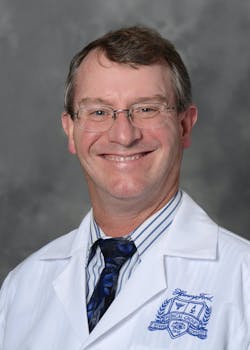Henry Ford Health: A leader in physician wellness, automation, and process improvement
It’s a question that many in the clinical laboratory C-suite are asking. How do we handle all-time-high testing volumes while also addressing the negative effects of growing caseloads and understaffing on the collective mental health of our medical laboratory personnel? Physician burnout and a lack of qualified laboratory technologists were pre-pandemic issues that have turned into full-blown crises within the industry.1,2 In terms of burnout, the numbers are very troubling. A recent poll by the American Society of Clinical Pathology (ASCP) revealed that burnout is widespread, with 71.4 percent of practicing pathologists saying they have felt burnout at some point on the job. Another 32.9 percent responded by saying that burnout was a current problem.
Anxiety and stress are on the rise thanks to several factors, with the most pressing issue being a lack of qualified personnel to assist pathologists with their unrelenting caseloads. It is estimated that the clinical lab industry is short some 25,000 laboratory technologists even as employable candidate numbers continue to plummet. Add to that, industrywide struggles with budgets impacted by the pandemic, inflation in the form of rising supply costs, and more expected reimbursement cuts, and you can understand how burnout is now a real threat to the profession.
But all is not lost. Some within the industry have been able to successfully navigate these uncertain times with programs that target burnout, understaffing, and inefficient processes. Henry Ford Health, one of the nation’s leading and largest healthcare providers with more than 1,900 physicians among its approximately 33,000 employees, has incorporated a wellness program, automation in the laboratory, and Lean management to navigate today’s staffing issues. What follows is a look at the steps taken by the organization as a whole, and the Pathology Informatics department in particular, to guard against physician burnout and understaffing.
There are significant challenges everywhere
J. Mark M Tuthill, MD, is the Division Head of Pathology Informatics at Henry Ford Health. He is a leading voice for pathology informatics and believes that patient care is directly enhanced by applying information technology to pathology and laboratory medicine. Tuthill leads a department that manages medical laboratory testing for 5 acute care hospitals and 263 ambulatory sites located throughout central and southeast Michigan. In a recent interview, he was asked to describe how burnout and staffing challenges have affected the medical group.
“There are significant challenges everywhere,” he said. “It's something that I'm very concerned about.” Tuthill said that a lack of available pathologists and a slowing pipeline in areas of pathology means current practitioners are forced to do more with less and that ultimately puts everyone at risk for burnout. “Look at what pathology labs have to do now to hire and retain staff. It goes beyond just bringing in med techs. The main challenge is finding qualified personnel to hire in the first place,” he said. The reasons for this are well known. The med tech pipeline has been undermined by universities that lack interest and appreciation for what they do, and when compared to nurses with equivalent training and experience, these technologists are compensated at roughly 50 cents on the dollar.
Tuthill said that the industry is still in a recovery mode economically post-pandemic. That coupled with increasing requirements for compensation is making a difficult situation even worse for everyone in healthcare.
The We Care Physician Wellness Program
For Tuthill and other members of the Henry Ford leadership team, physician burnout is not a new concept. He sits on a wellness committee that pre-dates the pandemic. The We Care Physician Wellness Program3 was first established by Lisa MacLean, MD, the medical group’s Chief Clinical Wellness Officer, in 2017.
At the time, a program like this was uncommon, but even back then Tuthill saw the need for it. “We were already recognizing signs of physician stress and burnout, plus a lack of availability for individuals who support physician activities. As a leadership group, we realized the need for wellness activities, especially for the professional staff,” he said.
So, even though the physicians at Henry Ford were consistently reporting burnout rates lower than the national average, Tuthill said a decision was made to do more, and a committee was formed with MacLean taking a leading role. According to MacLean, the overall strategy behind the wellness program was based on an existing Stanford model that recognized the need for a systemwide approach and a focus on the systemic problems that exist in healthcare and drive burnout. In those early days, her principal role was to both ask questions and listen to her colleagues. “It was important that I approach the role with humility,” she said. “There were others within the organization who also had a passion for this work, and I needed to harness their energy and add them to my small army of people tasked with preventing and mitigating burnout while also improving overall well-being.”
For MacLean, taking on this role was a natural next step after years of preparation. She first developed an interest in wellness and education as a Residency Program Director of Psychiatry at Henry Ford Hospital early in her career. From there, she further pursued her interest by becoming the Associate Dean of Students at Wayne State School of Medicine in 2012.
While at Wayne State, MacLean witnessed firsthand the negative impact that the curriculum and delivery of medical education were having on student well-being. Thats where she also became fully aware of the importance of having easy access to mental health support. “As I worked in that role to develop health and wellness programming for the students, I further fell in love with the work,” said MacLean, who also acknowledged her struggles with burnout during this point in her medical journey. “I felt that I had an important voice to bring to the table and wanted to further envelop myself in this work.”
After five years of refining her program at Wayne State, MacLean was ready for a change. Thats when she contacted Henry Ford Health and shared a white paper with leadership that outlined her plans and why they should hire her to lead a wellness program. Henry Ford Health did just that in 2017, and the creation of MacLean’s position coincided with a mandate from the Accreditation Council for Graduate Medical Education calling for all institutions that sponsor residency and fellowship programs to have wellness programming.
“My journey began there, and I can attest that it’s been challenging work, especially in the context of all the systemic healthcare delivery problems that currently exist,” stated MacLean. “No doubt, medicine attracts high-achieving, resilient, gritty people but when they are placed into situations that do not allow them to do the work that matters the most, and they are not working at the top of their license, this drives distress and burnout.”
MacLean says the coronavirus pandemic hugely impacted healthcare and providers in a very palpable way. She says she’s still seeing the effects of this today. “I’m seeing more exhaustion, angst, and suffering than before,” she said. “Many feel the system is the problem. I agree that the system is problematic, but I also feel that, as individuals, we need to strive to control what we can and pay attention to what we do. How we interact, how we show up, and how we take responsibility for our self-care.”
Creating a happier workforce
At Henry Ford Health, the wellness program is run by physicians for physicians. The primary goal is to optimize healthy coping strategies and help physicians find a good work–life balance that will allow them to deliver high-quality care and find greater satisfaction in their careers and lives. “It’s all about creating a happier workforce,” said Tuthill. “We try to identify the issues and take actionable steps to correct them, so colleagues don’t take patient work home with them when they leave work.” Tuthill also noted that the program provides emotional and psychiatric help discreetly so those experiencing high-stress levels, anxiety, and/or depression can get the help they need without being placed in jeopardy for doing so.
Since the advent of the program, Henry Ford Health leadership has supported the hiring of a health psychologist for psychotherapy and two psychiatrists for medication support. Additionally, the group has changed its credentialing questionnaire by removing a question asking about a clinician’s mental health treatment history. Also noteworthy is the fact that the medical group has updated its vacation policy, so physicians now get the maximum amount of vacation after 10 years of service. “We strive to break down walls and barriers and open doors so that people who need mental health treatment can easily seek it,” said MacLean.
In Tuthill’s experience, even a little gesture of kindness in the form of a wellness cart with clowns, balloons, and candy can make people feel valued and appreciated. “Our carts travel around the health system, visiting departments and floors. It makes you stop and think about wellness, and this is a primary goal for the committee. We want our colleagues and our healthcare system to take ownership of wellness. To be more mindful and intentional about their well-being,” said Tuthill.
The role of automation and pathology informatics
It’s unfortunate, but most often true in all forms of business: When budgets are strained, non-value-added services and human resources are cut to make up the difference. Tuthill acknowledged that this is a scenario many pathology labs are facing today. Even under the weight of burnout and understaffing, human resources are being targeted. Doing more with less is nothing new for anyone who has spent time in a clinical laboratory, but how can these businesses survive and even thrive during turbulent times?
For Henry Ford Health, it starts with automation.
“If we didn't have the automated chemistry line and the automated staining solutions in histology, and if we weren't extensively using barcode technology to drive all of our interactions with these assets, we wouldn't be able to keep the lab running,” said Tuthill. “Without automation, we’d be closing our doors.”
Tuthill also suggested that labs with well-deployed technology in areas like digital pathology, molecular technology, and lab automation may have an edge in the retention and recruitment of staff. “In the end, it comes down to automating processes and eliminating defects by standardizing work and using lab analytics,” he said. “The two are interrelated.” Simply stated, without lab analytics, you cannot see where the problems are.
“Some of these problems live deep under the hood, and it takes a lot of effort to get under the hood and find them,” he said. Tuthill used a label issue problem as an example. During recent quality assurance work on the automation line, his department identified a pre-analytic problem. The lab was receiving defective tubes that had unreadable labels. This resulted in the need to reprocess all of those samples in the defective tubes. According to Tuthill, this minor issue could have translated into a $200,000 annual cost if it wasn’t caught. However, the issue was solved with regular printer maintenance and adjustments to the formatting of the label.
“Identifying simple things like this and then focusing efforts to solve the problem, most organizations don’t have the wherewithal to do this,” said Tuthill. “It’s something we’ve committed to because we know if we fix these problems, we’re going to save time and staff requirements.”
The Henry Ford Production System and its adaption of Lean management
At Henry Ford Health, the commitment to being a world-class laboratory organization dedicated to a lean culture and relentless improvement dates back to 2005. That’s when leadership first integrated the concept of the Henry Ford Production System into their lab operations to eliminate wasteful practices and innovate more efficient processes that focus on the needs of the patient.4
“There's nothing that information technology likes better than lean quality management because it gets people to use our systems efficiently and consistently, and that allows us to identify defects and resolve them,” said Tuthill, who also noted that keeping the present lean culture intact is in itself a tremendous effort because of inevitable staff turnover and retraining.
A key component of the Henry Ford Production System is the empowerment of every employee to improve their work product or service. Every employee has a voice and is incentivized to seek continuous improvement at his or her level of work. “Finding ways to improve efficiency allows us to do what we do,” concluded Tuthill. “With our very defined culture, all staff members can take ownership of their roles, identify deficiencies in standardized processes, and work to solve them in the most efficient manner possible.”
That brings to mind a phrase first attributed to Henry Ford back in 1918: ‘Quality is what counts, and nothing but quality.’ That phrase remains a guiding principle for Tuthill and his pathology informatics team, and they strive to live up to this standard every day.
REFERENCES
1. The causes and consequences of pathologist burnout. Ligolab.com. Accessed November 21, 2023. https://www.ligolab.com/post/the-causes-and-consequences-of-pathologist-burnout.
2. What caused the current shortage of medical laboratory technologists and what steps need to be taken to solve the problem. Ligolab.com. Accessed November 21, 2023. https://www.ligolab.com/post/what-caused-the-current-shortage-of-medical-laboratory-technologists-and-what-steps-need-to-be-taken-to-solve-the-problem.
3. Physician wellness program. Henryford.com. Accessed November 21, 2023. https://www.henryford.com/hcp/physician-wellness-program.
4. Production System. Henryford.com. Accessed November 21, 2023. https://www.henryford.com/hcp/academic/pathology/production-system.
About the Author

Michael Kalinowski
Since 2019, Michael Kalinowski has led marketing and communication efforts for LigoLab Information Systems. LigoLab is a laboratory information system (LIS) company specializing in comprehensive and highly configurable enterprise-grade software solutions that help independent pathology groups and clinical labs modernize their businesses and grow efficiently.


